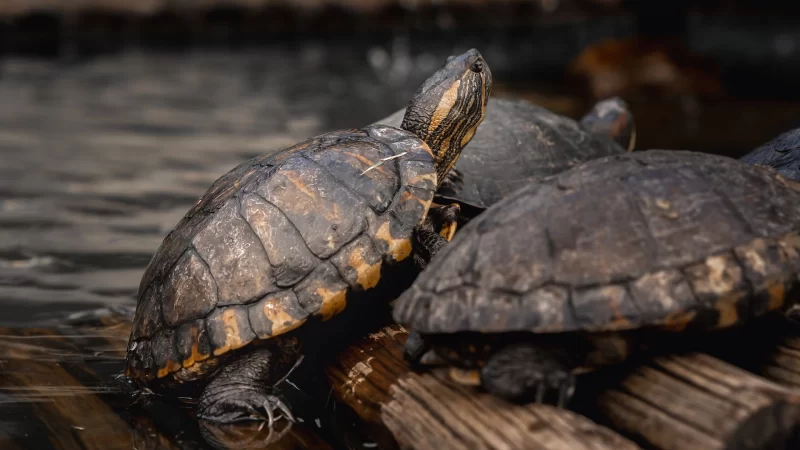Turtle Without Shell, Is It Harmful? Common Possibilities And Guide

Turtle Without Shell: When someone first sees a tortoise or turtle, they can assume something about its anatomy that isn’t true. This makes sense. Humans have delicate skin and cover themselves with clothes.
A tortoise or turtle’s shell resembles a massive coat of armour. Even their little legs, heads, and tails seem to be protruding out of the shell as if they could simply slip out whenever they wanted to.
Turtle Without Shell, what would happen? Can turtles and tortoises survive without their shells, then?
Turtle Without Shell
Without their shells, turtles and tortoises cannot survive.
They can’t just put on and take off the shell like that. They are unable to survive without it since it is attached to the bones of turtles and tortoises.
In truth, a tortoise or turtle’s shell has nerve endings, which means it can sense your touch and experience pain if its shell is injured.
It would be comparable to asking a person to survive without their skin to expect a tortoise to live without its shell.
Please continue reading to understand more about this as there are some crucial points to remember. The survival of your turtle or tortoise may be at stake.
Why Turtle And Tortoise Shells?
Without their shells, can turtles and tortoises survive? While the question makes me cringe, understanding the response is crucial.
Nevertheless, you must first comprehend what the shell is and how it functions in order to fully comprehend the significance of the question and the response.
What Is shell How It Functions?
The growth patterns of turtle and tortoise shells are very similar. These gorgeous reptiles cannot wriggle into or out of their shell. They never moult nor emerge from their shells.
As they are an integral component of the animal’s body, a turtle or tortoise’s shell constantly grows along with it. It’s going to be the ideal size forever.
A tortoise’s exoskeleton includes its shell. It simply implies that, unlike a human skeleton, a portion of the skeletal system is located outside of the body.
The upper exoskeleton of tortoises and turtles is linked to the ribs and spine.
Painful Shells Are Sensitive
You would experience severe agony if you shattered your arm since it is a component of your skeleton. Similar to that is the tortoise shell.
Because of the delicate nerve endings in and around the shell, a tortoise or turtle may detect your touch, a blow to the body, and attempt to remove the shell.
Also, it implies that if a turtle or tortoise develops a crack or hole in its shell, it is equivalent to you breaking a bone.
Recommended: Tortoise Hibernation OR Dead? Best Ways To Determine
Many Shells For A Variety Of Uses
While much of this page applies to both turtles and tortoises, it’s important to note that their shells may vary somewhat.
For instance, since they are terrestrial creatures, turtles need their shells for protection from the elements.
Since they spend most of their life in the water, turtles must be streamlined and smooth to move through it.
As a result, tortoises have keratin-coated, very hard, bone-like shells. Your fingernails are formed of that substance.
Sea turtles’ shells are covered with a leather-like material. Shells from both land and sea turtles may land wherever in between.
All tortoise and turtle shells, regardless of their external coverings, have the potential to be broken and inflict the animal severe agony.
Can Turtles And Tortoises Emerge From Their Shells?
No, and you shouldn’t ever attempt to pressure them to. A tortoise or turtle’s shell cannot be removed without endangering the animal since it is a component of its exoskeleton.
The turtle would suffer a tremendous deal and die if he tried to accomplish it.
Please, please, please do not attempt to pry a turtle or tortoise out of its shell! Consider having your spine and ribs removed or having the skin of your back peeled off. Not exactly a nice idea, is it?
They may tuck their limbs inside their shells even if they are unable to exit them. Some creatures can even tightly shut their shells, sealing them off from the outside world.
But never attempt to crack a turtle or tortoiseshell! If you attempt to pry open the shell, the animal will suffer damage from your efforts due to the powerful muscles keeping it tight.
Can Turtles And Tortoises Live With Cracked Shells?
Fortunately, yes! While a cracked shell is an extremely dangerous medical condition, it may not always result in imminent death.
When a turtle or tortoise’s shell cracks or breaks, the body is exposed. It resembles a skin gash or a split in your fingernail. If left untreated, any injury like this might result in serious illnesses.
A cracked or shattered shell may not always be the consequence of trauma.
Ulcers on and around the shell may be brought on by an unhealthy diet and unclean tank conditions. The condition is known as “shell rot,” and it may be fatal.
Many illnesses, a lack of calcium, inadequate sunshine, and anomalies in the shell may all lead to shell ulcers.
If your tortoise or turtle is displaying indications of shell rot, look out for indicators of renal impairment, liver illness, and thyroid problems.
Do Tortoise Shells Naturally Repair Themselves?
Nature is an amazing thing. Being living, organic, natural materials, tortoise and turtle shells have the capacity to mend on their own.
A tortoiseshell may heal by itself, much as your damaged arm would gradually mend.
Despite the fact that the shells may recover on their own, it is important to treat a broken or cracked shell right away.
As was already said, even the tiniest fracture may expose your pet to deadly microorganisms that can cause death.
Veterinarians may speed up the healing process by injecting antibiotics into the affected area and then caulking the crack with a unique bonding substance.
While smaller fractures and cracks are simpler to repair than bigger holes, let your veterinarian make the final decision. Even though it seems awful to you, the hole may not be that difficult to patch.
How Are The Shells Of Turtles And Tortoises Formed?
All newborn turtles and tortoises have shells. The hatchling is well protected by its shell, despite the fact that it may be softer than an adult’s shell.
While they grow and mature, unlike some other creatures, turtles and tortoises do not moult and develop a new shell. Instead, the turtle’s shells develop alongside it.
The shell develops at the same rate as the rest of its skeletal system since it is a component of the exoskeleton.
Land turtles and tortoises have rounder, thicker shell that is covered with specific plates, while sea turtles have somewhat softer shells with leathery covering.
Scutes, which are the plates, develop throughout time, overlap, and sometimes shed off. Yet, only turtles shed their scutes; tortoises never do.
Instead, tortoise scutes just continue to expand and overlap.
Why Are Turtles And Tortoises Covered With Shells?
The evolution of turtles and tortoises’ shells is unknown, but some recent findings have paved the path for an understanding of how, why, and when it happened.
The Eunotosaurus africanus fossils, which were recently found, were the missing connection between earlier fossils of non-shelled turtles and contemporary turtles and tortoises.
Biologists are using this “in-between” shell to better understand how turtle shells have evolved.
We do know that tortoises and turtles typically employ their shells as a kind of defence. Predators have trouble opening tall, spherical shells with their mouths closed.
Predators find it almost hard to eat or scrape through tough shells. Sea turtles also benefit from a coat of armour to ward off any potential predators despite having weaker shells.
Pursuing The Truth
It goes without saying that the owners of turtle and tortoise shells are very well protected. But, according to one expert, these shells developed for a different function.
Tortoise and turtle shells may have developed as a means of aiding in digging, according to Tyler Lyson from the Denver Museum of Nature and Science.
While there are still many questions, this novel concept is gaining traction.
Their predecessors’ shells were precisely formed for balance, strength, and efficient digging, whether they were digging in the muck for food or burrowing in the sand to escape the heat.
With the string claws discovered on the remains, this argument is particularly compelling.
Conclusion
Without its shell, a turtle or tortoise would suffer a torturous death. It’s a horrific thought, and when doing research for this post, I came across a number of images and movies that I regret seeing.
It was worth the nightmares, however, if it helps others take better care of their beloved tortoises. Observe your pet turtle carefully. Maintain her cage and provide her with a healthy diet.
Keep an eye out for cracks or holes in her shell, and if you see any, take her to the doctor immediately soon. If caught in time, a broken shell could be repaired.
Hope you like this information about (Turtle Without Shell) provided by Globlar.com, and if you really like that, don’t forget to share it with your beloved! Thanks
FAQ’s
How Do Turtles Get Their Shells?
The shells of turtles and tortoises are present from birth. Although they may be softer when they first hatch, they soon harden and provide greater animal protection.
Their shells expand and strengthen with them as they age.
How Are Turtles’ Shells Grown?
To develop and keep their shells in good condition, turtles need enough calcium.
To maintain the shell expanding at the same rate as the rest of their body, they also require a range of vitamins and minerals from their food.
Turtles either have scales or scutes, formed of keratin that covers their bony shells or a leather-like covering over their cartilage shells.
Turtles’ Shells Can Be Changed?
No. Every turtle and tortoise has a single shell at birth. While certain turtles may do so when new scutes grow, they do not shed their shell.
Since they are unable to leave their shells, turtles and tortoises are unable to transition to new shells.














